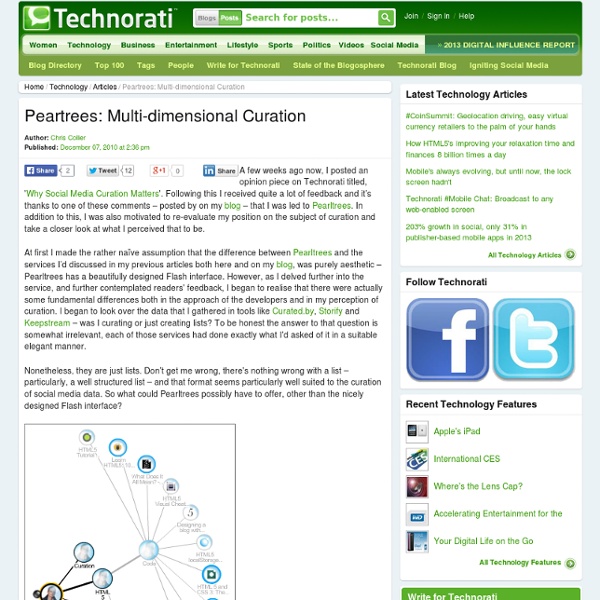Peartrees: Multi-dimensional Curation
A few weeks ago now, I posted an opinion piece on Technorati titled, 'Why Social Media Curation Matters'. Following this I received quite a lot of feedback and it’s thanks to one of these comments – posted by on my blog – that I was led to Pearltrees. In addition to this, I was also motivated to re-evaluate my position on the subject of curation and take a closer look at what I perceived that to be. At first I made the rather naïve assumption that the difference between Pearltrees and the services I’d discussed in my previous articles both here and on my blog, was purely aesthetic – Pearltrees has a beautifully designed Flash interface. However, as I delved further into the service, and further contemplated readers' feedback, I began to realise that there were actually some fundamental differences both in the approach of the developers and in my perception of curation. Nonetheless, they are just lists. The answer can be summed up in one word, depth.
9 content curation tools that better organise the web.
Content curation is a huge deal on the web today. As content on the web grows exponentially, our ability to make sense of it is inversely proportional. In other words, we are fast sinking under the sheer amount of content pouring onto the web every day. The social web hasn’t made life any easier on content production either – in fact its lowered the barrier to entry. URL: Redux has over the past year grown organically to become one of the web’s best places for finding great content. URL: A new startup still in Beta, Scoop.it again allows you to create topic centric information, and share with others. As with Redux, a way to ‘follow’ users and content as also been implemented to allow you to receive updates within a topic, and you can also suggest additional sites for the administrator of that topic hub to add to their curated masterpiece. URL: URL: URL: URL:
PearlTrees: Social Bookmarking introduces Teams
pensée Kodo (percussions)
Exploring the limitless possibilities of the traditional Japanese drum, the taiko, Kodo is forging new directions for a vibrant living art-form. In Japanese the word "Kodo" conveys two meanings: Firstly, "heartbeat" the primal source of all rhythm. The sound of the great taiko is said to resemble a mother's heartbeat as felt in the womb, and it is no myth that babies are often lulled asleep by its thunderous vibrations. Secondly, read in a different way, the word can mean "children of the drum," a reflection of Kodo's desire to play the drums simply, with the heart of a child. Kodo strives to both preserve and re-interpret traditional Japanese performing arts.
Pearltrees: What problem does Pearltrees solve
4 Promising Curation Tools That Help Make Sense of the Web
Steven Rosenbaum is a curator, author, filmmaker and entrepreneur. He is the CEO of Magnify.net, a real-time video curation engine for publishers, brands, and websites. His book Curation Nation is slated to be published this spring by McGrawHill Business. As the volume of content swirling around the web continues to grow, we're finding ourselves drowning in a deluge of data. Where is the relevant material? The solution on the horizon is curation. In the past 90 days alone, there has been an explosion of new software offerings that are the early leaders in the curation tools category. 1. Storify co-founder Burt Herman worked as a reporter for the Associated Press during a 12-year career, six of those in news management as a bureau chief and supervising correspondent. At the AP, editors sending messages to reporters asking them to do a story would regularly write, “Can u pls storify?” Storify is currently invite only. 2. Scoop.it is often described as Tumblr without the blog. 3. 4.
Welcome - curated.by
pearltrees > blog
mythe féminin
La reine Esther est troublante à bien des égards, et l'étude de son personnage soulève des questions difficiles à éluder : - Pourquoi l'auteur du livre d'Esther a-t-il fait appel aux légendes des dieux babyloniens, Ishtar et Mardouk, qu'il a en quelque sorte "cachérisés" ? - Pourquoi chante-t-on les mérites d'une jeune fille juive qui abandonne son peuple pour se donner à un roi idolâtre ? - Pourquoi loue-t-on son tuteur, qui prostitue de cette manière sa pupille ? - Pourquoi le livre se termine-t-il par l'extermination générale des habitants de Suse par les Juifs, menés par Esther et Mardochée, et par l'évocation de l'allégresse qui s'ensuit ? Esther - Ishtar : L'auteur du Livre d'Esther n'a pas craint de donner à ses héros des noms empruntés à la mythologie babylonienne, comme s'il était évident pour les lecteurs de son époque que les Juifs exilés en Perse pouvaient s'identifier aux dieux locaux ! Qui est Ishtar ? Esther-Ishtar est donc l'incarnation de la féminité Esther – Hadassah
Related:
Related:




Curons curoons! et cultivons nos perles! by jubault Dec 8